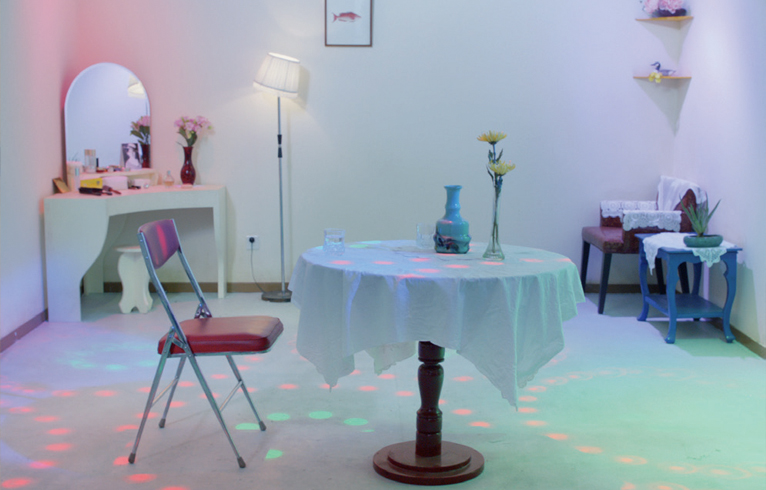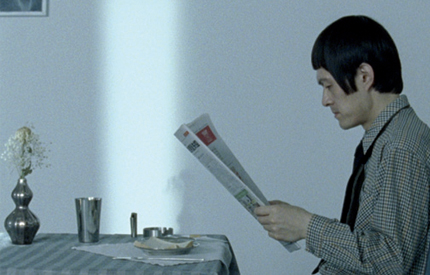XIAO WU | MORNING!
| February 17, 2012 | Post In LEAP 12

DANCING WITH STILLNESS
Text: Chen Zhou / Translation: Marianna Cerini
In Beijing one can still find a few ballrooms that cropped up at the end of the 1970s. In today’s society, these ballrooms have come to represent a specific trait of that era, and together with the people who frequented them, they have kept the clothing, music, and atmosphere typical of that time. Similarly, the ballrooms’ changing rooms have become a sort of semantic space-time tunnel. It is in this space linking past and present that, over time, the complex relationship between memory and age takes place.
In the dynamics of the present, the existence of ballrooms seems to be somehow at a standstill, and that is why the author of Xiao Wu has planned so many levels of “stillness” in the film. The first level regards the narrative. The whole film depicts the process of a middle age woman putting make-up on before going out; the scene is slow, stagnant. The act of applying makeup seems to slowly pull this modern woman back into memories of the past. Catering to the entire film’s set and tone, the director has extracted the visual aesthetic of the late 1970s, which emerges abstractly in set design and lighting. These stage elements, however, are not realistic reconstructions of a bygone era; rather, they are constructed vaguely, in a layer of the “past within present.”
The second plane of “stillness” concerns scene— which perhaps calls for a bit of an explanation: in one scene, in her right hand the protagonist holds a mirror, which reveals her considering her appearance from behind; this still action carries on for five seconds. The stillness remains as the film cuts on to the next scene, wherein the woman, seen from behind and just having fastened the back zipper on her dress, sits frozen for five more seconds until she finally begins to move.
Part of the author’s creative process involved examining a great deal of old photos, and studying the postures most evocative of that era. On camera, these postures are frozen, emblematic of the era; in Xiao Wu, they are frozen in stillness. Yet in the latter this stillness is put into constant motion and, more importantly, throughout the same scene. If cut into one single shot, the five-second stillness undoubtedly resembles a photo, but it is precisely the sudden motionlessness of the movement that captures the existence of those ballrooms. And here, the language of film finds expression in the deployment of the self.

ACTIVE OR PASSIVE?
Text: Hao Jingban / Translation: Marianna Cerini
In this film, the director’s reflection on the “character” immediately reminds us of Robert Bresson’s definition of an actor. In a way, the protagonist in Morning! could actually be described as a “model”— as Bresson designated his performers— rather than as an “actor.” A “model” is a body subjected entirely to the will of the auteur, forced to reproduce the lines and gestures the latter provides. Throughout the film, he does not take part in any performance, to the effect that he doesn’t even embody the specific character of traditional acting methods.
Using the mechanical, almost unconscious process of reproduction of the model, a conscious “truth” that transcends model and director appears. With the powerful air of primitive art, the film touches on two extremes— the creativity of pure art, and its passivity in the face of things with their own expressive power. In other words, the picture has a contradictory dual nature: The auteur has complete control over what or whom he is shooting, but it is under this control that objects fail to bear any additional apparent meaning of “truth.”
Active or passive?
Morning!’s creator clearly raises this question to the art of cinema and to himself. In his soliloquy, the protagonist seems to be constantly shifting his persona, leading us to wonder whether we are actually watching his monologue, whether the director is using the scene to discuss the images he shot, or if, perhaps, the director is simply talking about himself. No matter whether in reality or in the film, to what extent are the two men actually in control of their own arguments? “You have no choice, it seems like everything has been pre-planned, I am like an actor controlled by the director. Sometimes, even, I cannot distinguish fantasy from reality. What should I do?”
In the end, the film is more than just scenes in front of a camera; it is a series of permutations and combinations that the images assume during the montage. Thus, what we see is not only the encounter between “will” and “chance,” but also a close relationship between the montage and the visible “truth” of the objects. For Bresson there is no distinction between the model and other elements; they are all “pieces of nature.” Jacques Rancière believes the role of art is to manipulate, combine and arrange these “pieces of nature” so as to reveal their intrinsic truth and, like “flowers in water,” regain life once more. The intimacy of the narrator’s voice, the faint touch of color, and the warmth bestowed by the 16mm film leave the viewer feeling sorrowfully confused. It appears that the director is starting to accept the arrangements of life, choosing to comply with the conflicting duality of the images by actively dispelling himself in the name of controlling them during the montage. Halfway though the film, the exposed sliding camera lens, the jokes told by the narrator, repetition of scene, and the removal of relatively meaningless parts of narration become increasingly effective. As the film begins to gradually build in mechanical, repetitive, atypical mode, its emotional message becomes so extremely apparent that the viewer is lead to feel emotions of despair.
Yes, we are allowed to feel such emotion, for as Jean Epstein said— the film is real, the story is a lie.

